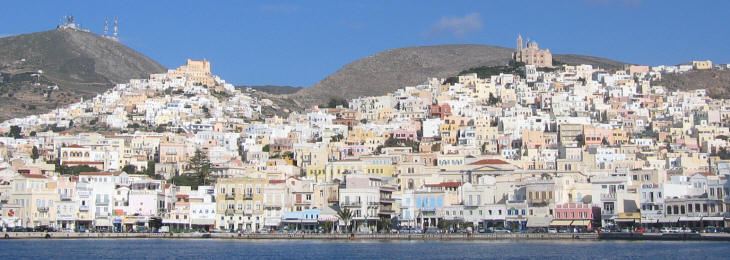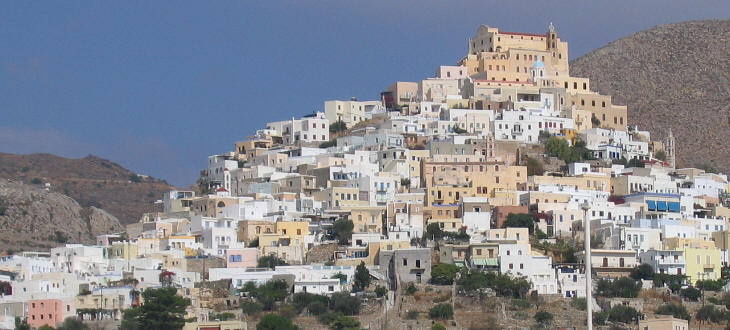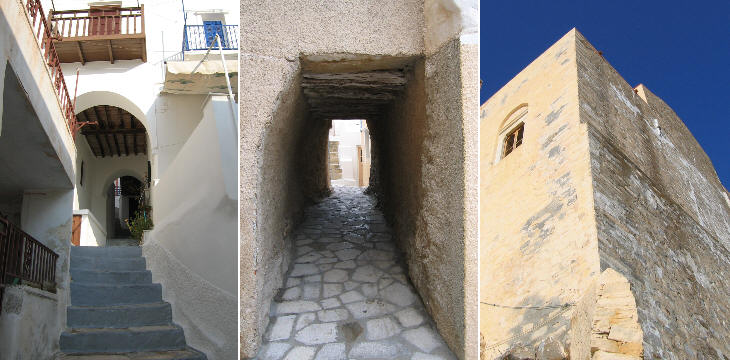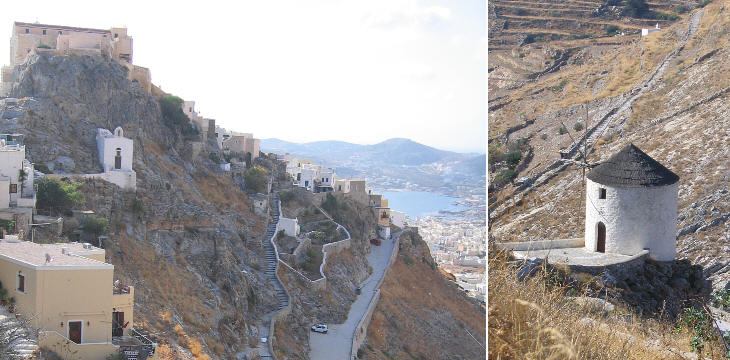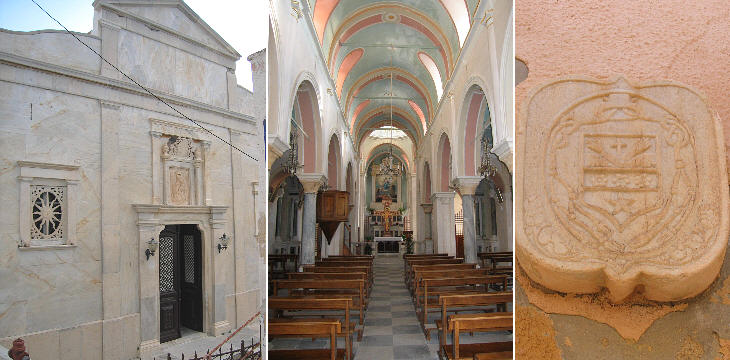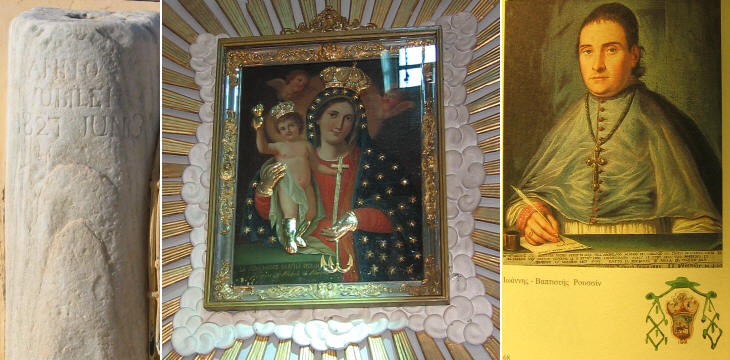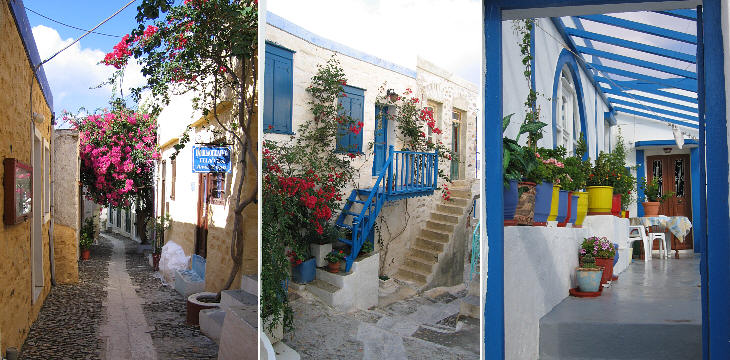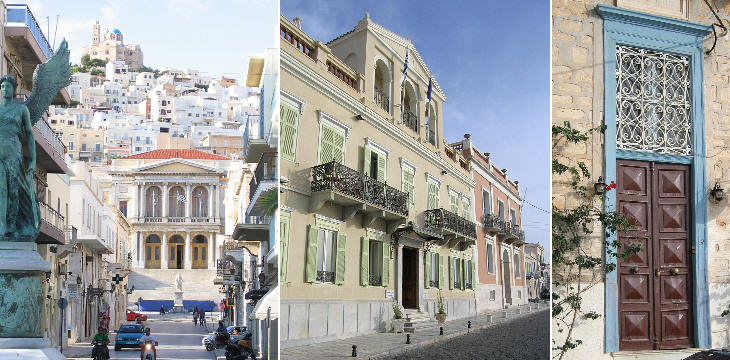  What's New! Detailed Sitemap All images © by Roberto Piperno, owner of the domain. Write to romapip@quipo.it. Text edited by Rosamie Moore. Page revised in December 2006. |
 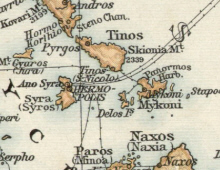 Siro (Syros) Siro (Syros)
Key dates: 1207 Marco Sanudo a Venetian adventurer conquered Nasso and the nearby islands including Siro 1566 The last Duke of Nasso, Jacopo IV Crispo was cashiered by the Sultan 1645-69 During the War of Candia the Venetians often controlled the Cycladic islands including Siro Siro is a small island which became important in the early XIXth century when refugees from Chios founded Ermoupolis which soon became the main port, not only of the Cyclades, but of the whole newly established Kingdom of Greece. Later on the development of Piraeus led to a change of the trading routes and Ermoupolis lost its importance. It is still the administrative capital of the Cyclades and for this reason it has ferries linking it with the smaller islands.
Two hills, each with a large church on top, constitute the most remarkable landscape feature of Siro and they provide a clue to the history of the island: Ano Syros (Upper Syros) on a high hill rather distant from the harbour is the old Venetian town while the church with a blue dome on the other hill (Vrondado) is the Orthodox Cathedral of Ermoupolis.
Ano Syros is now part of Ermoupolis, but it still retains most of the appearance one figures out from old engravings (one of which can be seen in the image used as background for this page).
Notwithstanding some modern modifications the top of the hill where the feudal lords of Siro had their residence can still be reached through very few points of access: the narrow street leading to the very top of Ano Syros has been most appropriately named after Thermopylae, the narrow passage where in 480 BC the Greeks held the Persians off.
While the side of the hill towards the sea has a workable slope and it was entirely built upon, the rear side of Ano Syros was too precipitous and was left in its natural state.
Siro was called the Pope's island because its inhabitants during the Venetian rule were almost entirely Catholic and they remained so also during the Ottoman domination: Jesuits, Capuchins and many other orders had their monasteries in Ano Syros: their churches were built following Italian patterns.
Siro is still a diocese (with Milo) and approximately 20% of the population of the whole island is Catholic. Minor communities of Catholics live in Andro, Tino, Nasso and Mykonos and constitute a separate diocese.
Ermoupolis The refugees who founded Ermoupolis dedicated their new town to Hermes, the Olympian god who was regarded as patron of commerce (maybe because he was also the patron of robbers). Ermoupolis was such a success story that the town was a candidate to becoming the capital of Greece: the ship-owners who lived in Ermoupolis built their mansions on a cliff overlooking the sea and the area was named Vaporia, (steamers).
Introductory page on the Venetian Fortresses Pages of this section: On the Ionian Islands: Corfų (Kerkyra) Paxo (Paxi) Santa Maura (Lefkadas) Cefalonia (Kephallonia) Asso (Assos) Itaca (Ithaki) Zante (Zachintos) Cerigo (Kythera) On the mainland: Butrinto (Butrint) Parga Preveza and Azio (Aktion) Vonizza (Vonitsa) Lepanto (Nafpaktos) Atene (Athens) On Morea: Castel di Morea (Rio), Castel di Rumelia (Antirio) and Patrasso (Patra) Castel Tornese (Hlemoutsi) and Glarenza Navarino (Pilo) and Calamata Modon (Methoni) Corone (Koroni) Braccio di Maina, Zarnata, Passavā and Chielefā Mistrā Corinto (Korinthos) Argo (Argos) Napoli di Romania (Nafplio) Malvasia (Monemvassia) On the Aegean Sea: Negroponte (Chalki) Castelrosso (Karistos) Oreo Lemno (Limnos) Schiatto (Skiathos) Scopello (Skopelos) Alonisso Schiro (Skyros) Andro (Andros) Tino (Tinos) Micono (Mykonos) Siro (Syros) Egina (Aegina) Spezzia (Spetse) Paris (Paros) Antiparis (Andiparos) Nasso (Naxos) Serifo (Serifos) Sifno (Syphnos) Milo (Milos) Argentiera (Kimolos) Santorino (Thira) Folegandro (Folegandros) Stampalia (Astipalea) Candia (Kriti) You may refresh your knowledge of the history of Venice in the Levant by reading an abstract from the History of Venice by Thomas Salmon, published in 1754. The Italian text is accompanied by an English summary. Clickable Map of the Ionian and Aegean Seas with links to the Venetian fortresses and to other locations (opens in a separate window) |
